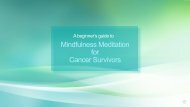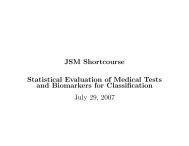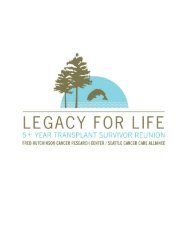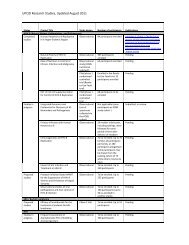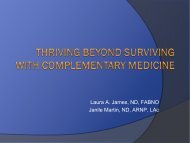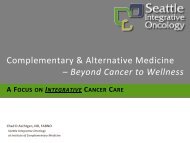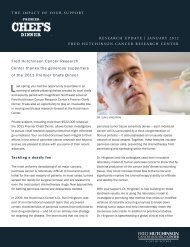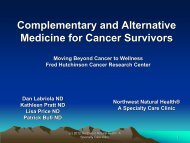Chronic GVHD Provider Survey
Chronic GVHD Provider Survey
Chronic GVHD Provider Survey
Create successful ePaper yourself
Turn your PDF publications into a flip-book with our unique Google optimized e-Paper software.
BMT CTN 0801 Protocol<br />
<strong>Chronic</strong> <strong>GVHD</strong> <strong>Provider</strong> <strong>Survey</strong><br />
ENROLLMENT<br />
Instructions:<br />
Please score a symptom only if you know or suspect it be related to chronic <strong>GVHD</strong>.<br />
Subjective symptoms are acceptable. For example, joint tightness can be scored based on<br />
subjective findings despite the absence of objective limitations.<br />
Please score symptoms present in the last week. Even if they may have resolved with treatment in<br />
the past week, if they were present recently and may possibly return, please score them.<br />
You will need to complete this survey upon for the patient’s baseline visit upon enrollment.<br />
Patient Name:<br />
MRN:<br />
BMT CTN 0801 ID#<br />
c<strong>GVHD</strong> Dx Date:<br />
<strong>Provider</strong> Name (printed):<br />
<strong>Provider</strong> Signature<br />
Date of Assessment:<br />
BMT CTN 0801 <strong>Provider</strong> <strong>Survey</strong> - Enrollment, v 2.0 Page 1 of 11
Section 1: SKIN<br />
Dermatological Sentinel Lesion?<br />
Erythematous<br />
rash of any sort<br />
Moveable<br />
sclerosis<br />
BMT CTN 0801 <strong>Provider</strong> <strong>Survey</strong> - Enrollment, v 2.0 Page 2 of 11<br />
Non‐moveable<br />
subcutaneous<br />
sclerosis or fasciitis<br />
1. Head/neck/scalp 1-Yes 2-No % % %<br />
2. Anterior torso 1-Yes 2-No % % %<br />
3. Posterior torso 1-Yes 2-No % % %<br />
4. L. upper extremity 1-Yes 2-No % % %<br />
5. R. upper extremity 1-Yes 2-No % % %<br />
6. L. lower extremity, (incl. L 1-Yes 2-No % % %<br />
7. R. lower extremity, (incl. R 1-Yes 2-No % % %<br />
buttock)<br />
8. Genitalia not examined 1-Yes 2-No % % %<br />
9. Skin<br />
sclerotic<br />
changes<br />
10. Skin<br />
Score<br />
11. Fascia<br />
Clinical Skin Features<br />
12. Ulcer? 1- Yes<br />
2- No<br />
0 1 2 3 4<br />
Normal Thickened<br />
with pockets<br />
of normal<br />
skin<br />
Thickened<br />
over majority<br />
of skin<br />
Thickened,<br />
unable to<br />
move<br />
0 1 2 3<br />
No Symptoms 50% BSA OR deep<br />
sclerotic features<br />
“hidebound” (unable<br />
to pinch) OR<br />
impaired mobility,<br />
ulceration or severe<br />
pruritus<br />
Tight Tight, unable to move<br />
14. Largest dimension: (cm)<br />
15. Maculopapular rash 1‐ Yes 2‐ No 16. Keratosis pilaris<br />
18. Papulosquamous lesions<br />
1‐ Yes 2‐ No<br />
17. Lichen planus‐like lesions 1‐ Yes 2‐ No or icthyosis<br />
1‐ Yes 2‐ No<br />
19. Poikiloderma 1‐ Yes 2‐ No 20. Hair involvement 1‐ Yes 2‐ No<br />
21. Pruritus 1‐ Yes 2‐ No 22. Nail involvement 1‐ Yes 2‐ No<br />
23. Other 1‐ Yes 2‐ No 24. Other, specify:
Region<br />
25. Head,<br />
Neck and Scalp<br />
26. Chest<br />
27. Abdomen<br />
and Genitals<br />
28. Back and<br />
Buttocks<br />
29. Right Arm<br />
Sentinel<br />
Lesion<br />
1‐ Yes 2‐ No<br />
1‐ Yes 2‐ No<br />
1‐ Yes 2‐ No<br />
1‐ Yes 2‐ No<br />
1‐ Yes 2‐ No<br />
Section 1: SKIN<br />
Grade<br />
(see below)<br />
0 1‐ Yes 2‐ No %<br />
1 1‐ Yes 2‐ No %<br />
2 1‐ Yes 2‐ No %<br />
% Area of Grade<br />
Fraction of<br />
Grade 3 or 4 Areas with<br />
Erythema<br />
(indicate up to what fraction is<br />
involved)<br />
3 1‐ Yes 2‐ No % 0 ¼ ½ ¾ 1<br />
4 1‐ Yes 2‐ No % 0 ¼ ½ ¾ 1<br />
Total = 100 %<br />
0 1‐ Yes 2‐ No %<br />
1 1‐ Yes 2‐ No %<br />
2 1‐ Yes 2‐ No %<br />
3 1‐ Yes 2‐ No % 0 ¼ ½ ¾ 1<br />
4 1‐ Yes 2‐ No % 0 ¼ ½ ¾ 1<br />
Total = 100 %<br />
0 1‐ Yes 2‐ No %<br />
1 1‐ Yes 2‐ No %<br />
2 1‐ Yes 2‐ No %<br />
3 1‐ Yes 2‐ No % 0 ¼ ½ ¾ 1<br />
4 1‐ Yes 2‐ No % 0 ¼ ½ ¾ 1<br />
Total = 100 %<br />
0 1‐ Yes 2‐ No %<br />
1 1‐ Yes 2‐ No %<br />
2 1‐ Yes 2‐ No %<br />
3 1‐ Yes 2‐ No % 0 ¼ ½ ¾ 1<br />
4 1‐ Yes 2‐ No % 0 ¼ ½ ¾ 1<br />
Total = 100 %<br />
0 1‐ Yes 2‐ No %<br />
1 1‐ Yes 2‐ No %<br />
2 1‐ Yes 2‐ No %<br />
3 1‐ Yes 2‐ No % 0 ¼ ½ ¾ 1<br />
4 1‐ Yes 2‐ No % 0 ¼ ½ ¾ 1<br />
Total = 100 %<br />
Grade Description<br />
0 = normal skin<br />
1 = discolored [hypopigmentation, hyperpigmentation, alopecia, erythema, maculopapular rash]<br />
2 = lichenoid plaque, or skin thickened (able to move)<br />
3 = skin thickened with limited motion but able to pinch [scleroderma or fasciae involvement]<br />
4 = hidebound skin, unable to move, unable to pinch<br />
BMT CTN 0801 <strong>Provider</strong> <strong>Survey</strong> - Enrollment, v 2.0 Page 3 of 11
Region<br />
30. Right Hand<br />
31. Left Arm<br />
32. Left Hand<br />
33. Right Leg<br />
and Foot<br />
34. Left Leg and<br />
Foot<br />
Sentinel<br />
Lesion<br />
1‐ Yes 2‐ No<br />
1‐ Yes 2‐ No<br />
1‐ Yes 2‐ No<br />
1‐ Yes 2‐ No<br />
1‐ Yes 2‐ No<br />
Section 1: SKIN<br />
Grade<br />
(see below)<br />
0 1‐ Yes 2‐ No %<br />
1 1‐ Yes 2‐ No %<br />
2 1‐ Yes 2‐ No %<br />
% Area of Grade<br />
Fraction of<br />
Grade 3 or 4 Areas with Erythema<br />
3 1‐ Yes 2‐ No % 0 ¼ ½ ¾ 1<br />
4 1‐ Yes 2‐ No % 0 ¼ ½ ¾ 1<br />
Total = 100 %<br />
0 1‐ Yes 2‐ No %<br />
1 1‐ Yes 2‐ No %<br />
2 1‐ Yes 2‐ No %<br />
3 1‐ Yes 2‐ No % 0 ¼ ½ ¾ 1<br />
4 1‐ Yes 2‐ No % 0 ¼ ½ ¾ 1<br />
Total = 100 %<br />
0 1‐ Yes 2‐ No %<br />
1 1‐ Yes 2‐ No %<br />
2 1‐ Yes 2‐ No %<br />
3 1‐ Yes 2‐ No % 0 ¼ ½ ¾ 1<br />
4 1‐ Yes 2‐ No % 0 ¼ ½ ¾ 1<br />
Total = 100 %<br />
0 1‐ Yes 2‐ No %<br />
1 1‐ Yes 2‐ No %<br />
2 1‐ Yes 2‐ No %<br />
3 1‐ Yes 2‐ No % 0 ¼ ½ ¾ 1<br />
4 1‐ Yes 2‐ No % 0 ¼ ½ ¾ 1<br />
Total = 100 %<br />
0 1‐ Yes 2‐ No %<br />
1 1‐ Yes 2‐ No %<br />
2 1‐ Yes 2‐ No %<br />
3 1‐ Yes 2‐ No % 0 ¼ ½ ¾ 1<br />
4 1‐ Yes 2‐ No % 0 ¼ ½ ¾ 1<br />
Total = 100 %<br />
Grade Description<br />
0 = normal skin<br />
1 = discolored [hypopigmentation, hyperpigmentation, alopecia, erythema, maculopapular rash]<br />
2 = lichenoid plaque, or skin thickened (able to move)<br />
3 = skin thickened with limited motion but able to pinch [scleroderma or fasciae involvement]<br />
4 = hidebound skin, unable to move, unable to pinch<br />
BMT CTN 0801 <strong>Provider</strong> <strong>Survey</strong> - Enrollment, v 2.0 Page 4 of 11
Section 2: ROM & MOUTH<br />
Please circle this person’s current ROM for each joint from 1=poor mobility to 7=full mobility below:<br />
1. Shoulder<br />
2. Elbow<br />
3. Wrist and fingers<br />
4. Foot Dorsiflexion<br />
5. Mouth Score No<br />
symptoms<br />
Mouth<br />
0 1 2 3<br />
Mild symptoms<br />
with disease<br />
signs but not<br />
limiting oral<br />
intake<br />
significantly<br />
6. Erythema None Mild erythema<br />
OR<br />
Moderate<br />
erythema (
1. GI Tract Score<br />
Gastro‐<br />
intestinal<br />
2. Esophagus<br />
Dysphagia OR<br />
Odynophagia<br />
3. Upper GI<br />
Early satiety OR<br />
Anorexia<br />
OR<br />
Nausea &<br />
vomiting<br />
4. Lower GI<br />
Diarrhea<br />
Section 3: GASTROINTESTINAL<br />
No<br />
symptoms<br />
0 1 2 3<br />
No<br />
esophageal<br />
symptoms<br />
No<br />
symptoms<br />
No loose or<br />
liquid stools<br />
during the<br />
past week<br />
Symptoms<br />
such as<br />
dysphagia,<br />
anorexia,<br />
nausea,<br />
vomiting,<br />
abdominal pain<br />
or diarrhea<br />
without<br />
significant<br />
weight loss<br />
(15%, requires<br />
nutritional<br />
supplement for<br />
most calorie<br />
needs OR<br />
esophageal<br />
dilation<br />
Dysphagia or<br />
odynophagia<br />
for almost all<br />
oral intake, on<br />
almost every day<br />
of the past week<br />
More severe<br />
or persistent<br />
symptoms<br />
throughout the<br />
day, with<br />
marked<br />
reduction in<br />
oral intake, on<br />
almost every day<br />
of the past week<br />
Voluminous<br />
diarrhea on<br />
almost every day<br />
of the past week<br />
requiring<br />
intervention to<br />
prevent or<br />
correct volume<br />
depletion<br />
BMT CTN 0801 <strong>Provider</strong> <strong>Survey</strong> - Enrollment, v 2.0 Page 6 of 11
1. Eye<br />
Score<br />
2. Joints<br />
and<br />
Fascia<br />
Score<br />
3. Genital<br />
Tract<br />
Score<br />
No GYN<br />
Exam or N/A<br />
(males)<br />
NB Score still<br />
required<br />
4. Lung<br />
Score<br />
5. Other<br />
Organ<br />
Score<br />
Specify organ1:<br />
6. Other<br />
Organ<br />
Score<br />
Specify organ2:<br />
No<br />
symptoms<br />
No<br />
symptoms<br />
No<br />
symptoms<br />
No<br />
symptoms<br />
Section 4: OTHER ORGANS<br />
0 1 2 3<br />
No effect on<br />
ADL<br />
____________<br />
No effect on<br />
ADL<br />
____________<br />
Mild dry eye<br />
symptoms not<br />
affecting ADL<br />
(requiring eye<br />
drops 3x per day or<br />
punctual plugs)<br />
WITHOUT vision<br />
impairment<br />
Tightness of arms or<br />
legs OR joint<br />
contractures,<br />
erythema thought<br />
due to fasciitis,<br />
moderate decrease<br />
ROM AND mild to<br />
moderate limitation<br />
of ADL<br />
Symptomatic with<br />
distinct signs on<br />
exam AND with<br />
mild dyspareunia or<br />
discomfort with<br />
GYN exam<br />
Moderate symptoms<br />
(shortness of breath<br />
after walking on flat<br />
ground)<br />
Moderate effect<br />
on ADL<br />
Moderate effect on<br />
ADL<br />
Severe dry eye<br />
symptoms<br />
significantly affecting<br />
ADL (special<br />
eyewear to relieve<br />
pain) OR unable to<br />
work because of<br />
ocular symptoms OR<br />
loss of vision caused<br />
by kerato‐<br />
conjunctivitis sicca<br />
Contracture WITH<br />
significant decrease<br />
of ROM AND<br />
significant limitation<br />
of ADL (unable to tie<br />
shoes, button shirts,<br />
dress self etc.)<br />
Symptomatic WITH<br />
advanced signs<br />
(stricture, labia<br />
agglutination or<br />
severe ulceration)<br />
AND severe pain<br />
with coitus or<br />
inability to insert<br />
vaginal spectrum<br />
Severe symptoms<br />
(shortness of breath<br />
at rest; requiring O2)<br />
Severe effect on ADL<br />
Severe effect on ADL<br />
BMT CTN 0801 <strong>Provider</strong> <strong>Survey</strong> - Enrollment, v 2.0 Page 7 of 11
Section 5: OVERALL STATUS<br />
1. Please rate the severity of this person’s chronic <strong>GVHD</strong> on the two scales below:<br />
a. None (1) Mild (2) Moderate (3) Severe (4)<br />
b. <br />
c<strong>GVHD</strong> symptoms are not at all severe c<strong>GVHD</strong> symptoms are most severe as possible<br />
0 1 2 3 4 5 6 7 8 9 10<br />
2. Was therapeutic regimen changed? 1‐Yes 2‐No If yes, indicate how it was changed below.<br />
a. Adjust levels of medications 1‐Yes 2‐No<br />
b. Enroll on clinical trial 1‐Yes 2‐No<br />
c. Worsening of symptoms 1‐Yes 2‐No<br />
d. No improvement in symptoms 1‐Yes 2‐No<br />
e. Toxicity 1‐Yes 2‐No<br />
f. New symptoms 1‐Yes 2‐No<br />
g. Improvement in symptoms 1‐Yes 2‐No<br />
h. Disease relapse 1‐Yes 2‐No<br />
i. Stable 1‐Yes 2‐No<br />
3. Does this person currently have: 0‐ No <strong>GVHD</strong><br />
1‐ Late acute <strong>GVHD</strong><br />
2‐ Overlap acute and chronic <strong>GVHD</strong><br />
3‐ Classic chronic <strong>GVHD</strong><br />
4. Sentinel Organ (If more than one, please rank with<br />
Indicate which organ system will guide your treatment decisions 1 being first and 4 being last)<br />
a. Skin 0‐No, will not guide 1‐ 2‐ 3‐ 4‐<br />
b. Joints 0‐No, will not guide 1‐ 2‐ 3‐ 4‐<br />
c. Fascia 0‐No, will not guide 1‐ 2‐ 3‐ 4‐<br />
d. Lung 0‐No, will not guide 1‐ 2‐ 3‐ 4‐<br />
e. Urogenital 0‐No, will not guide 1‐ 2‐ 3‐ 4‐<br />
f. Liver 0‐No, will not guide 1‐ 2‐ 3‐ 4‐<br />
g. Mouth 0‐No, will not guide 1‐ 2‐ 3‐ 4‐<br />
h. Esophagus 0‐No, will not guide 1‐ 2‐ 3‐ 4‐<br />
i. Lower GI 0‐No, will not guide 1‐ 2‐ 3‐ 4‐<br />
j. Other 0‐No, will not guide 1‐ 2‐ 3‐ 4‐<br />
k. Specify other<br />
BMT CTN 0801 <strong>Provider</strong> <strong>Survey</strong> - Enrollment, v 2.0 Page 8 of 11
Section 6: OTHER INDICATORS, CLINICAL MANIFESTATIONS<br />
OR SEVERE COMPLICATIONS RELATED TO CHRONIC <strong>GVHD</strong><br />
Other indicators, clinical manifestations or severe complications related to chronic<br />
<strong>GVHD</strong><br />
Never<br />
(0)<br />
Past,<br />
not now<br />
(1)<br />
Mild<br />
(2)<br />
Moderate<br />
(3)<br />
Severe<br />
(4)<br />
1. Pleural Effusion(s) <br />
2. Bronchiolitis obliterans <br />
3. Bronchiolitis obliterans<br />
organizing pneumonia<br />
<br />
4. Nephrotic syndrome <br />
5. Malabsorption <br />
6. Esophageal stricture<br />
or web<br />
<br />
7. Ascites (serositis) <br />
8. Myasthenia Gravis <br />
9. Peripheral Neuropathy <br />
10. Polymyositis <br />
11. Pericardial Effusion <br />
12. Cardiomyopathy <br />
13. Cardiac conduction defects <br />
14. Coronary artery<br />
involvement<br />
15a. Other 1, please specify:<br />
____________________<br />
15b. Other 2, please specify:<br />
____________________<br />
15c. Other 3, please specify:<br />
____________________<br />
<br />
<br />
<br />
<br />
Please continue to the next page<br />
BMT CTN 0801 <strong>Provider</strong> <strong>Survey</strong> - Enrollment, v 2.0 Page 9 of 11
Section 6: OTHER INDICATORS, CLINICAL MANIFESTATIONS<br />
OR SEVERE COMPLICATIONS RELATED TO CHRONIC <strong>GVHD</strong><br />
16. Infection<br />
0 1 2 3 4<br />
None Mild,<br />
topical or<br />
no<br />
therapy<br />
required<br />
If 2, 3, or 4, then select one:<br />
Moderate, localized,<br />
requiring oral<br />
treatment<br />
Pending<br />
lab<br />
report<br />
Unidentified<br />
organism<br />
Severe,<br />
systemic<br />
infection<br />
requiring IV<br />
anti‐infective,<br />
mold‐active<br />
oral antifungal<br />
or<br />
hospitalization<br />
Life‐<br />
threatening<br />
infection<br />
Identified organism, specify:<br />
17. Peripheral Edema? None (0) Trace (9) 1+ 2+ 3+ 4+<br />
Section 7: FUNCTIONAL TESTS (may be assessed by the <strong>Provider</strong> or<br />
other personnel at the center)<br />
1. Two Minute Walk Test - assessed by: _____________________________ Date __________<br />
Total Distance walked in two minutes __________ feet<br />
2. Grip Strength - assessed by: _____________________________ Date __________<br />
Trial #1 __________ lbs or __________ kg<br />
Trial #2 __________ lbs or __________ kg<br />
Trial #3 __________ lbs or __________ kg<br />
3. Schirmer’s Eye Exam - assessed by: _____________________________ Date __________<br />
RIGHT Eye (OD) __________ mm<br />
LEFT Eye (OS) __________ mm<br />
BMT CTN 0801 <strong>Provider</strong> <strong>Survey</strong> - Enrollment, v 2.0 Page 10 of 11
BMT CTN 0801 Protocol<br />
<strong>Chronic</strong> <strong>GVHD</strong> <strong>Provider</strong> <strong>Survey</strong><br />
ENROLLMENT<br />
For office use only<br />
Study ID Initials (First, Last) Date completed:<br />
Visit Number- Day 0 Date entered:<br />
Contact Person at Site:<br />
Phone Number:<br />
Date received:<br />
The BMT CTN 0801 <strong>Provider</strong> <strong>Survey</strong> is complete. Please provide to<br />
the data coordinator to enter in AdvantageEDC and save the original<br />
copy in the patient’s research chart.<br />
BMT CTN 0801 <strong>Provider</strong> <strong>Survey</strong> - Enrollment, v 2.0 Page 11 of 11



